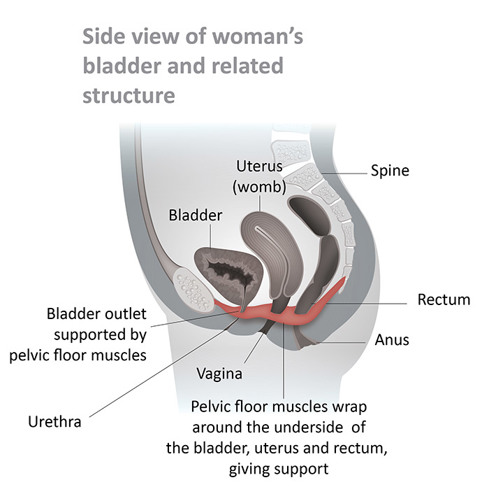Information about your pelvic floor and how to do pelvic exercises.
The pelvic floor is made up of layers of muscles which support the bladder, bowel and uterus.
Strengthening your pelvic floor muscles will help with incontinence.
Your pelvic floor will not be very strong initially after childbirth.
You may also feel that you have difficulties working with your pelvic floor and that you have little sensation.
This usually improves with time, but the more you are able to work your pelvic floor, the quicker the recovery will be.
You may find that you have trouble controlling your bladder and if you have this problem, you may need to see a physiotherapist to help you strengthen your pelvic floor.
Tighten your pelvic floor. You can do this by imagining you are desperate to pass urine and you are trying to stop yourself. Hold this for as many seconds as you can, up to a maximum of 10 seconds.
Release and rest for 5 seconds.
Repeat this 'tighten, hold and release' movement as many times as you can. Aim to do 10 in a row. These exercises will increase your stamina.
You should work at your own speed, and you will need to determine your own 'starting level'. For example, if you can hold the contraction for 2 seconds and repeat 4 times, this is your starting level.
To increase the reaction of your pelvic floor muscles you should also do some 'fast squeezes'. To do this, tighten your muscles as before, but stronger and faster. Then release straight away. Aim to do 10 of these in a row.
You should try and do these exercises at least twice a day.
You can do them anywhere at any time! However, do not do them whilst you are passing urine.
Initially it may be easier to do them lying down.
You can then try them sitting, or standing.

Women’s health physiotherapists offer specialist assessment and rehabilitation for pelvic, bladder and bowel pain and dysfunction.
These symptoms are often associated with pregnancy, birth and menopause.
You can be referred to these services by your GP, or sometimes you can refer yourself directly by getting in touch with them.
In some maternity units there are Women’s Health Physiotherapists based on the postnatal ward and you can see them after you have had your baby.
The NHS has further information about accessing physiotherapy:
https://www.nhs.uk/conditions/physiotherapy/accessing/
After pregnancy, avoid high impact exercise and heavy lifting for 4-6 weeks.
This is particularly important for women who have had a third- or fourth-degree tear.
After 4-6 weeks you can gradually increase your general activity.
Further reading and resources
NHS: What are pelvic floor exercises
https://www.nhs.uk/common-health-questions/womens-health/what-are-pelvic-floor-exercises/
Bladder & Bowel Foundation: Pelvic floor exercises
https://www.nhs.uk/Planners/pregnancycareplanner/Documents/BandBF_pelvic_floor_women.pdf (PDF)
